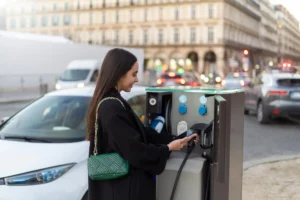
Home / EV Charging News / Electric Car Charging Infrastructure in National Parks: Examining the installation of charging stations in protected natural areas to support electric vehicle travel and promote eco-tourism
The integration of electric vehicle (EV) charging infrastructure within national parks represents a significant stride towards sustainable transportation and eco-tourism. This article delves into the necessity for such infrastructure, the advantages it brings to both visitors and the environment, the challenges faced in its implementation, and successful case studies to draw inspiration from.
In an era where environmental concerns loom large, transitioning to sustainable transportation solutions is imperative. National parks, as hubs of natural beauty and biodiversity, attract millions of visitors annually. However, conventional transportation methods contribute to pollution and disrupt the fragile ecosystems within these protected areas. Introducing electric vehicle charging infrastructure addresses these concerns by providing a clean mode of transportation for park visitors.
The adoption of electric vehicles within national parks offers multifaceted benefits. Firstly, it significantly reduces carbon emissions and noise pollution, thus preserving the serenity and ecological balance of these natural habitats. Secondly, EVs promote energy efficiency and lessen dependence on fossil fuels, aligning with broader sustainability goals. Moreover, EVs offer a smoother and quieter ride, enhancing the overall visitor experience within national parks.
The installation of EV charging infrastructure complements conservation efforts within national parks. By encouraging the use of electric vehicles, park authorities can mitigate air and noise pollution, safeguarding the diverse flora and fauna. Additionally, reduced reliance on internal combustion engine vehicles diminishes the risk of oil spills and other environmental hazards, further protecting sensitive ecosystems. This synergy between sustainable transportation and conservation enhances the long-term preservation of national park resources.
Despite its numerous benefits, integrating EV charging infrastructure within national parks poses several challenges. Limited access to electricity grids in remote park locations presents logistical hurdles in establishing charging stations. Additionally, concerns regarding visual impact and disruption to natural landscapes necessitate careful planning and stakeholder engagement. Moreover, the high initial costs associated with infrastructure installation and maintenance may deter park authorities from pursuing electrification initiatives.
Several national parks have successfully implemented EV charging infrastructure, serving as exemplary models for others. For instance, Yosemite National Park in California has strategically placed charging stations at visitor centers and lodges, facilitating EV travel throughout the park. Similarly, Acadia National Park in Maine has collaborated with local utility companies to install charging stations powered by renewable energy sources, further enhancing its eco-friendly initiatives. These case studies underscore the feasibility and benefits of integrating EV charging infrastructure within national parks.
The availability of EV charging infrastructure enhances the overall visitor experience within national parks. EV drivers can explore the park without the anxiety of running out of battery charge, thereby extending their stay and engaging in more recreational activities. Moreover, the convenience of charging stations encourages visitors to adopt sustainable transportation practices, contributing to a culture of environmental consciousness and responsible tourism.
The promotion of eco-tourism through electric car charging infrastructure yields significant economic and social benefits. By attracting environmentally conscious travelers, national parks can stimulate local economies through increased visitor spending on accommodations, dining, and recreational activities. Furthermore, eco-tourism initiatives create employment opportunities within adjacent communities, fostering economic growth and social development. Additionally, by showcasing the importance of environmental stewardship, these initiatives instill a sense of pride and responsibility among residents and visitors alike.
Successful implementation of EV charging infrastructure in national parks hinges upon robust community engagement and stakeholder collaboration. Local communities, utility companies, environmental organizations, and governmental agencies must collaborate to address the logistical, financial, and regulatory challenges associated with infrastructure deployment. Engaging stakeholders in the planning process ensures that diverse perspectives are considered, fostering a sense of ownership and collective responsibility towards achieving sustainability goals.
As the adoption of electric vehicles continues to rise, scaling electric car charging networks within national parks becomes increasingly pertinent. Park authorities should adopt a proactive approach by conducting regular assessments of visitor demand, technological advancements, and evolving regulatory frameworks to expand and optimize charging infrastructure. Collaborating with private sector partners and leveraging innovative financing mechanisms can facilitate the rapid deployment of charging stations, ensuring seamless access for EV drivers across diverse park landscapes.
The installation of electric car charging infrastructure in national parks represents a transformative step towards sustainable transportation and eco-tourism promotion. By facilitating EV travel, national parks can minimize environmental impact, enhance visitor experiences, and bolster conservation efforts. The economic, social, and environmental benefits of promoting eco-tourism through electric car charging infrastructure underscore its significance in fostering a harmonious relationship between human recreation and natural preservation. Moving forward, collaborative efforts and strategic planning are essential to scale charging networks and realize the full potential of sustainable transportation within protected natural areas.
